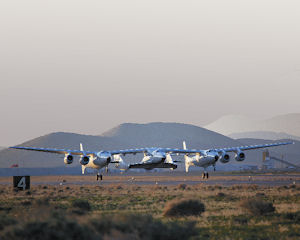Four Southern California aerospace companies will use their space vehicles to transport scientific experiments and equipment into near Earth orbit as part of a $10 million NASA contract. Whittinghill Aerospace in Camarillo, and Virgin Galactic, XCOR Aerospace and Masten Space Systems, all based at the Mojave Air & Space Port in the Antelope Valley, are among seven companies that were selected to participate in the space agency’s program. The goal of the program is to encourage advances in space technology while providing low-cost access to sub-orbital altitudes for experiments. The agency’s move reinforces that the region is a hub for the nascent NewSpace industry, which appears poised to grow even as NASA’s mission is scaled back in the post-Space Shuttle era. The Mojave Air & Space Port, in particular, has become a hotspot for innovation in space vehicle development. “We are doing something right,” said Stuart Witt, the general manager of the air and space port. “It is clear the Aerospace Valley still plays a key role in innovation.” NASA selected the four area aerospace companies in part because they demonstrated the ability to get their vehicles flying within two years. The other companies taking part in the NASA program are Armadillo Aerospace in Texas, Near Space Corp. in Oregon and Up Aerospace Inc. in Colorado. Each company will receive between $10,000 and $5 million based on their ability to fulfill the NASA requirements of getting the experiments and equipment into space, said LK Kubendran, program executive with NASA’S Flight Opportunities Program. The seven companies have been pre-qualified by NASA to transport scientific and technological payloads, or space cargo, 62 miles above the Earth. Going to that altitude is an improvement over parabolic flights in modified passenger jets or cargo jets, because experiments are exposed to a longer duration of weightlessness. The four Southern California companies are at different stages in developing their space vehicles. Virgin Galactic leads the pack with its SpaceShipTwo, which is going through the flight testing phase at Mojave. The six-passenger craft and its carrier vehicle, the WhiteKnightTwo, were developed and built by Scaled Composites, also based in Mojave. NASA’s program is an endorsement of the strong research value of sub-orbital reusable vehicles, said Virgin Galactic President and CEO George Whitesides. SpaceShipTwo and other private space vehicles will change the paradigm of scientific research with more frequent flights, as well as the ability of scientists to fly with their experiments — all done at a lower cost, Whitesides said. “We are not talking millions of dollars here,” Whitesides said. The cargo taken into space would be a minimum of 1 kilogram, but a larger vehicle like SpaceShipTwo could probably fly 500 kilograms or more, Kubendran said. George Whittinghill, founder of the aerospace company bearing his last name, foresees payloads the size of a shoebox taken up in his 30-foot-long vehicle dubbed the MCLV, or minimum cost launch vehicle. “It doesn’t have a glamorous name yet,” Whittinghill quipped. A former employee of NASA based in Houston, Whittinghill left the agency to enter the commercial space industry. He started his own company seven years ago. Taking part in the NASA program fits in with his company’s business model — namely low-cost, dedicated launch services, Whittinghill said. “The idea is that we launch whenever (the customer) wants us to launch,” Whittinghill said. “They could ask us for a rapid turnaround of five days and we’ll do it.” Whittinghill is currently building the MCLV in Camarillo and does rocket engine testing at Mojave. XOCR Aerospace is assembling the two-seat Lynx vehicle in a hangar at the space port. The company plans to go airborne in flight tests in late 2012. Using the Lynx, scientists can travel aboard the ship with their experiment. The vehicle also gives scientists the option of using a pod, which is attached to the outside of the space vehicle and is large enough to hold a telescope or nano-satellite, said XOCR spokesman Mike Massee. Taking scientific payloads to space helps to expand a niche within the company’s larger customer base, Massee said, noting those customers are expected to be paying passengers. “They (NASA) are helping to spur the market,” Massee said. “NASA will supply the money to pay for the flight costs and in exchange there will be a sharing of information.” The Lynx and SpaceShipTwo attracted attention from the scientific community even prior to the announcement of the flight opportunities program. Earlier this year, the Southwest Research Institute reserved seats aboard both vehicles with options for additional flights. While Virgin Galactic has received much attention in the space tourism industry, it has been the hope of the company to get a strong share of buzz from the scientific research market. “We do see this is as a start of an exciting area and that it will be a good business area,” Whitesides said. The Mojave space port aims to provide an ideal environment for companies such as Virgin Galactic, XCOR Aerospace and Masten Space Systems to explore new frontiers in space, Witt said. Along with affordable hangar rates, the port provides an unrestricted airspace for testing. And companies don’t have to worry about receiving noise complaints from their rocket engines, he said. “You cannot have innovation without taking risks and giving people permission to try, and that is all we do,” Witt said.
